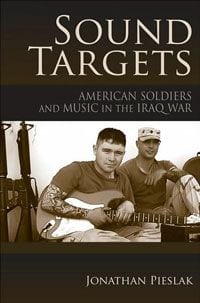
What does the average 18-24 year-old American kid listen to while psyching himself up to kill somebody? According to Jonathon Pieslak’s Sound Targets, a scholarly look at American soldiers’ use of music during combat in Iraq, the sonic drug of choice is probably Metallica.
While Slayer and Eminem both make prominent showings, and while Numetal acts like Godsmack pop up increasingly on pre-mission play lists, Metallica still rules the improvised sound systems of Humvees and armored personnel carriers across the Iraqi battlefield. Maybe that’s because songs like “One” and “Disposable Heroes”, with their machine-gun rhythms and convincingly angry accounts of the destruction brought by war resonate with soldiers.
Maybe, as Pieslak implies, it’s the “guttural growls” and “Phrygian/Locrian modes.” Or more likely, it’s just good music to listen to when you feel like you might have to kick the shit out of somebody.
Pieslak never states anything half as plainly as that, though, and it’s too bad. His research unearths plenty of interesting facts about the role of music in war, the military’s history of using music as a recruiting tool and the ways music is used in psychological operations, both in occupied town squares and in the interrogation rooms of places like Abu Ghraib.
But Pieslak’s academic tendencies overshadow his storytelling abilities. His penchant for big words and footnotes is one of those traits which make so many university press books unappealing to average readers. His first chapter, for example, devotes a half-page to perfect fifths, melodic fragments and modal variations in the theme song for the movie Superman, a music-majors-only discussion that reads like an algebraic equation.
But then he ignores big questions, like the weird dichotomy between the artist’s creative intent and the always unpredictable response by the listener. What, for example, does Metallica think about all those jarheads rocking out to “Seek and Destroy” while they actually seek and destroy? And would the band be interested to know that the vast majority of soldiers listening to “Kill ’Em All” through the speakers of their tank helmets are doing so without paying for all those songs?
While Pieslak spills a lot of ink parsing the obvious connections between depictions of violence in certain forms of popular music and the real violence of warfare, he fails to question why the fruits of American culture are so violent in the first place, and why working class kids like those who fight our wars are so enamored of it.
Maybe that’s too much to ask from this book. And while it isn’t much of a page-turner, it’s nonetheless interesting, and one could find it quite useful as an unofficial companion to some of the documentaries that deal with the role popular music plays in combat, like George Gittoes’ 2003, Soundtrack to War, which Pieslak borrows his book’s cover image from, or Occupation: Dreamland, in which a former bassist for a death metal band gets a taste of real blood in Fallujah.
In Soundtrack to War, a GI tells Gittoes, “War is Heavy metal…It’s fast paced, gets your adrenaline flowing…It helps you feel what you got to feel”. And there’s the crux of it. What else is music for, if not to help us access and accentuate emotions? It’s certainly no surprise that US soldiers in combat, most of them teenagers or not much older, would turn to popular music to reinforce their aggressive or escapist tendencies — hell, isn’t that why they listen to music even at home?

![Call for Papers: All Things Reconsidered [MUSIC] May-August 2024](https://www.popmatters.com/wp-content/uploads/2024/04/all-things-reconsidered-call-music-may-2024-720x380.jpg)



